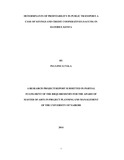| dc.description.abstract | Profitability is the primary goal of all business ventures. Without
profitability the business will not survive in the long run. So measuring current
and past profitability and projecting future profitability is very important.
Profitability is earned by carrying out business activities such as Transport
business. Public Transport is perceived to be the most important sector of
economy that provides transport services to the public. In Public Transport,
profitability is realized through daily transport services offered to the general
public. The purpose of this study was to establish the determinants of
profitability in Public Transport. The study was steered by the following
objectives: to establish how infrastructural factor is determinant of profitability
on Public transport, to establish how the service route factor is determinants of
profitability on Public Transport and to establish how urban mobility factor is
determinant of profitability in Public Transport. The study was conducted
through a survey research design. The study targeted the management and
drivers from different SACCOs in Eldoret town. The study selected four
SACCOs operating within Eldoret namely: Chepkoilel SACCO, Mailinne
SACCO, North Rift SACCO and Eldoret SACCO. The study employed the use
of purposive sampling to select the management staff while stratified sampling
was employed to select the various Public transport operators in the various
routes. The study used the Krejcie and Morgan formulae (1970) which gave a
sample size of 165 respondents when a researcher targets 294 respondents. The
study used both questionnaires and interview schedules to collect data. The
study adopted both quantitative and qualitative analysis in order to achieve the
objective of the study. In quantitative techniques the researcher used descriptive
statistics such as frequencies and percentages to analyze the data. The data was
coded using the statistical package for social scientist (SPSS), analyzed and
presented in form of tables, frequencies and percentages. The study findings
revealed that government regulation, infrastructure, service route and urban
mobility patterns determined the profitability in the Public Transport. These
factors were found to have a direct effect of the profitability. The study based on
the findings recommended that government as a regulator should involve the
entire stakeholder in formulation of policies so as to ensure fairness to all parties
involved; introduction of e-payment in the Public transport to curb corruption
and national and county government should invest more in road infrastructure
so as to enhance Public transport business. | en_US |

